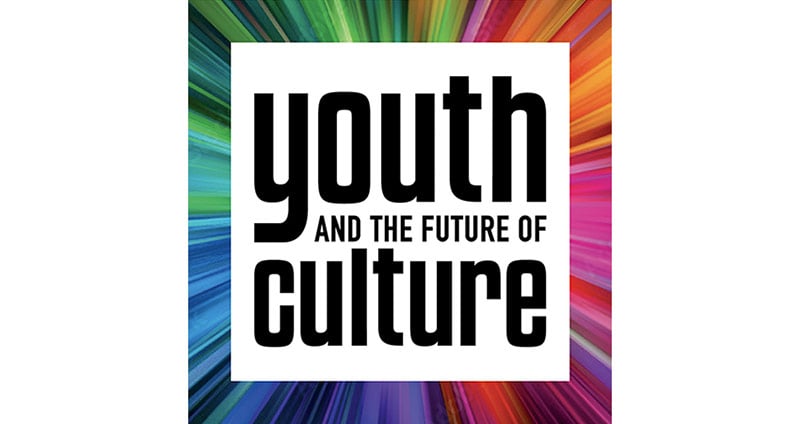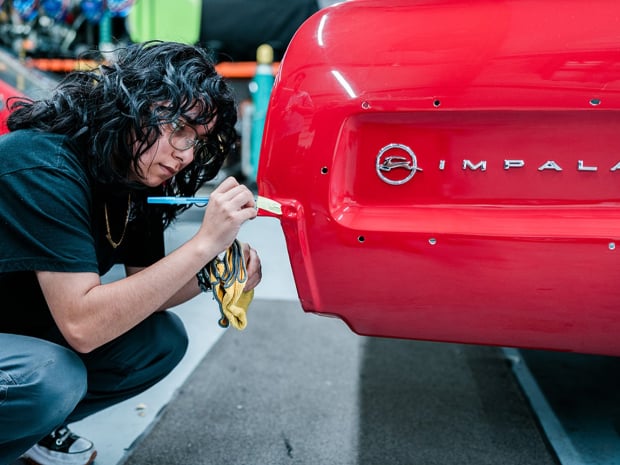Smithsonian Presents 2025 Annual Folklife Festival July 2–7
Festival Returns to Location on the Mall From Seventh to 12th Streets
Media Contact
Linda St. Thomas
Sophia Ancira
The Smithsonian Folklife Festival presents a wide-ranging theme this year: “Youth and the Future of Culture” featuring lowrider cars and bikes, skateboarders, teen fashion, filmmaking and traditional building arts and a Saturday night prom. Each part of the festival is led, created or presented by young people.
The festival opens Wednesday, July 2, and runs through Monday, July 7, along the National Mall on the Madison Avenue side, Seventh Street to 12th Street, and inside the Smithsonian’s Arts and Industries Building. Admission to the festival is free, and hours are from 11 a.m. to 5:30 p.m. each day, with featured concerts going later Thursday through Sunday. The schedule is available on the festival’s website. The festival is presented by the Smithsonian’s Center for Folklife and Cultural Heritage and co-sponsored by the National Park Service.
Streetwise
A large tent called “Streetwise” will highlight three forms of youth expression: lowrider culture, street art and graffiti, and skateboarding and skate arts. Visitors can watch the restoration of two cars with the iconic bold painting, special suspension system and chrome details, which are the hallmarks of the lowrider tradition that began in southern California in the 1940s and later spread around the globe. The action in “Streetwise” features skating demonstrations, painters working on murals and skate decks, teens customizing cars and bikes, and artisans from Indonesia making stylized adornments for lowriders. Music for this program is provided by teenage DJs. The lowriders program curator is Sojin Kim.
Museum of the Contemporary Teenager
The concept of the “teenager”—along with all the ideas, misconceptions, concerns and beliefs it evokes—was officially introduced to the American public in a 1913 newspaper article in Wilmington, Delaware. It became popular in the ’40s and ’50s as advertisers sought to reach a younger demographic of potential consumers.
The Museum of Contemporary American Teenagers (MoCAT) was started in 2017 by high school and middle school students in Montgomery County, Maryland. Their first pop-up museum was in an empty, single-story building scheduled for demolition. The first exhibit had installations on first love, phone addiction and risk taking. This first of many pop-ups also featured a maze of mental health, a FOMO (fear of missing out) pit and a ride-share simulator that recreated the experience of being a teen stuck in a car with an inappropriate driver.
For the Folklife Festival, MoCAT will bring together teenagers from across Washington, D.C., Maryland and Virginia to collaborate on exhibitions that highlight some of the dynamic and often overlooked youth movements that shape American culture. Their setting will feature venues representing a high school hallway, classroom, bedroom and bathroom where teens can share everything from fashion to their futures. Through performances, discussions and demonstrations, teen participants will explore topics as varied as “third spaces,” social media, fashion, slang and coming of age. MoCAT will also explore pressing topics such as school lockdowns and mental health, presented from the perspective of young advocates and activists. MoCAT students curated this area themselves under the guidance of Smithsonian curator Michelle Banks.
Music
The week will feature a variety of daytime and evening musical performances, showcasing youth groups and traditional music apprenticeship programs that honor and preserve their musical heritage. The lineup of local and national young musicians spans a broad range of genres, from mariachi to orchestral ensembles and folk contradance.
The featured concert series kicks off Thursday, July 3, with “Homegrown Futures: The Sound of D.C.,” dedicated to performers from the capital region. The festival celebrates July 4 with “Roots and Voices: Americana Reimagined.” “Prom in the Park” July 5 invites visitors to dress up and dance, and July 6 features “On Key: Next-Gen Music Ensembles” and a community contradance. The final day of the festival will close with a talent show.
Performers will also host a series of workshops and hands-on activities in the afternoons where visitors of all ages can explore the process and stories behind the music. The music program curators are Cristina Diaz-Carrera, Pablo Molinero-Martinez and Eloy Neira de la Cadena.
Films and Discussions
The Arts and Industries Building will serve as a theater during the festival with film screenings, workshops and talks with emerging media makers. The short films have been created by the Ghetto Film School (Los Angeles), Action Youth Media (Silver Spring, Maryland), Deanwood Radio Broadcast Youth Journalism Project (Washington, D.C.) and Wide Angle Youth Media (Baltimore). In addition, WXOX ARTxFM will be streaming live to 97.1 FM in Louisville, Kentucky, and online, capturing the sounds of the festival.
A special screening of the award-winning 90-minute documentary film The Ride Ahead, by disability activist and filmmaker Samuel Habib, will be held in the National Museum of American History’s Warner Bros. Theater. The film series program curator is Amalia Cordova.
Next Generation Artisans in the Traditional Building Trades
Skilled craftspeople in the building arts are vital to preserving the nation’s built environment and cultural heritage, but today many of these centuries-old skills are endangered—there are not enough young people practicing the traditional trades. Festival-goers will meet inspiring young craftspeople—stone carvers, decorative painters, preservation carpenters, stone masons, blacksmiths and ornamental plasterers—who are learning the building crafts from master artisans dedicated to passing on their knowledge and skills to the next generation. One of the best-known places for young people to get hands-on training from professionals is the American College of the Building Arts in Charleston, South Carolina. Stone carvers, architectural carpenters, architects and historic preservation specialists from the college will demonstrate their skills, share their experiences teaching and learning the building arts, and discuss why hand craftsmanship matters to them.
The Campaign for Historic Trades focuses on the skills needed to maintain, preserve, restore and reconstruct historic structures in local communities. It partners with the National Park Service’s Historic Preservation Training Center, which provides hands-on, historic preservation trade skills training to young people.
Festival visitors will meet experienced preservation carpenters and talented interns from George Washington’s Mount Vernon and learn about the 18th-century tools and techniques they use to preserve this iconic historic estate and its important American story.
Two highlights of this program come from the New Orleans Master Crafts Guild and the Washington National Cathedral Earthquake Restoration Project. A master blacksmith and plasterer and their apprentices from New Orleans will demonstrate their craft skills and share their thoughts on why teaching and learning the traditional trades is important to them. Cathedral craftspeople will demonstrate their techniques for restoring earthquake-damaged pinnacle stones, discuss on-the-job training in preservation craftsmanship at the cathedral and share information about opportunities for young people interested in stone carving and heritage masonry. The building trades program curator is Marjorie Hunt.
Native Language Reclamation
The Native American Languages Act of 1990 inspired a movement among Native communities to reclaim their native languages; many had not been spoken or written in a century. Today, youth are at the forefront of driving reclamation. The festival features four groups representing different languages and regions: Oklahoma, Indiana and Ohio; Upstate New York, Ontario and Quebec; Hawaii; and Kodiak Island, Alaska. In the Language Lodge, visitors can learn about these languages and how they can be passed on to future generations. To complement the language sessions, there will be lacrosse demonstrations, Kodiak Alutiiq social dances and demonstrations of Mohawk basket making.
Some Mohawk participants graduated from the Akwesasne Freedom School, which is one of the longest-running Native language schools. In addition to basket making demonstrations for festival-goers, they will offer cooking demonstrations using a traditional clay pot for their white corn dish. The language reclamation program curator is Mary Linn.
Accessibility
The festival strives to maintain an accessible and inclusive environment for all. Outdoor festival venues and activities are located in shaded grassy areas that are accessible via concrete sidewalks and/or packed gravel walkways. Accessible seating areas are available at all presentation venues and a limited number of wheelchairs are available for loan each day. All narrative and performance stages are equipped with assistive listening. American Sign Language (ASL) interpreters and real-time captioning are available for selected events. Additional ASL interpreting services may be requested and are provided as available. Verbal description tours and sighted guide services are available, along with large-print and Braille festival brochures and menus. A Sensory Map of the festival is also available. Accessibility service schedules and additional resources are available on the festival’s website or by visiting the Accessibility Tent on the festival site.
On Sunday morning, July 6, the festival will host “Morning on the Mall” for neurodivergent individuals and their families or others who may benefit from a more relaxed and supported environment. To find out more about this event or to request other access services not listed above, visitors may call (202) 633-2921 or email [email protected].
Sustainability
The festival’s sustainability program diverts as much waste from landfills as possible so it can be repurposed as a sustainable resource through recycling or compost. The program began in 2011 when the festival debuted water bottle collection and free water stations. The following year, a pilot composting program was launched at a staff event. These early steps culminated in a waste diversion project in 2013, which was the first year of composting, and it resulted in keeping 74% of the waste from landfills. By 2017, the festival hit 97% waste diversion, meriting an excellence award for sustainability from the American Alliance of Museums.
This year, the festival will continue efforts to achieve a diversion rate of over 90%. At stations located throughout the festival grounds, volunteers will help guests properly sort their trash. In addition, all festival staff and vendors receive training on festival sustainability guidelines while working on-site.
About the Festival
The Smithsonian Folklife Festival, inaugurated in 1967, honors contemporary living cultural traditions and celebrates those who practice and sustain them. Produced annually by the Smithsonian’s Center for Folklife and Cultural Heritage in partnership with the National Park Service, the festival has featured participants from all 50 states and more than 100 countries. Sabrina Motley is the director of the Folklife Festival, and Cliff Murphy is the director of the Center for Folklife and Cultural Heritage.
# # #
SI-92-2025



